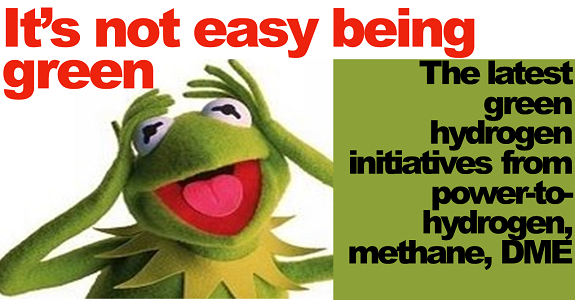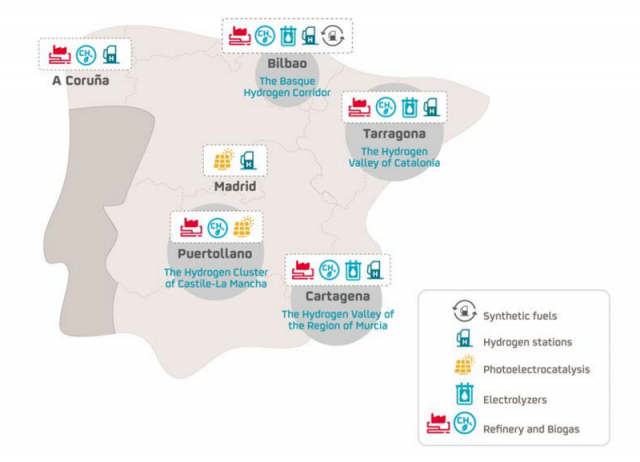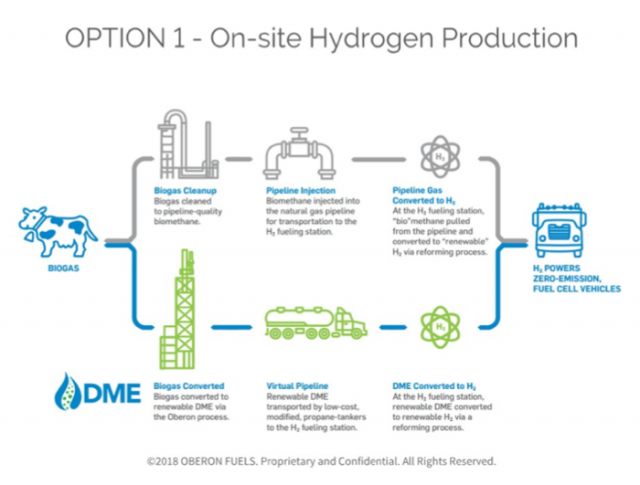Cummins, Sinopec, Oberon Fuels and more – The latest green hydrogen initiatives from power-to-hydrogen, methane, DME

It may not be easy for Kermit, but green hydrogen announcements have been many lately. What about the different routes to get that lovely green hydrogen? From splitting water via excess green power (power-to-hydrogen), to stripping hydrogen out of renewable methane or out of DME, here’s a look at some of the latest hydrogen initiatives.
In today’s Digest, from Cummins and Sinopec’s new JV to produce green hydrogen to Oberon Fuels producing hydrogen from DME, Repsol and Raven using biogas and municipal solid waste to produce green hydrogen, and the latest green hydrogen initiatives and news.
Cummins and Sinopec’s green hydrogen JV and power-to-hydrogen initiatives
Starting with one of the methods to produce hydrogen (power-to-hydrogen), there came news that Cummins Inc. and China Petrochemical Corporation (“Sinopec Group”) formed a 50:50 joint venture — Cummins Enze (Guangdong) Hydrogen Technology Co., Ltd (“Cummins Enze”). The joint venture will accelerate the affordability and availability of green hydrogen through increased technological innovation, research and development, and manufacturing capacity.
Cummins Enze, will be located in Foshan, Guangdong Province in China, will initially invest $47 million (RMB 300 million) to locate a manufacturing plant to produce proton exchange membrane (PEM) electrolyzers. The plant will initially have a manufacturing capacity of 500 megawatts of electrolyzers per year upon completion in 2023, which will be gradually increased over the next five years to reach one gigawatt of manufacturing capacity per year.
Cummins Enze will also provide a variety of hydrogen generation system solutions to meet diversified application requirements. This will include offering electrolyzers for both small-scale hydrogen production, such as a hydrogen fueling system for on-site hydrogen generation, as well as for large-scale hydrogen generation installations capable of 100 megawatts and beyond.
“China’s embrace of green hydrogen is a breakthrough for the planet, and Cummins and Sinopec joining together to realize the potential of green hydrogen is a huge leap forward for scaling our innovative PEM electrolyzer systems,” said Amy Davis, Vice President and President of New Power at Cummins. “Cummins was one of the first multinational companies to establish an entity in China in 1979, and we are thrilled to now use our deep roots and localized expertise to be at the forefront of the country’s energy transformation. This joint venture brings together Cummins’ and Sinopec’s innovative spirits and pursuit of a more sustainable tomorrow, enabling a carbon-free economy.”
“Green hydrogen is the ultimate technology of the hydrogen energy industry in the future,” said Zhou Yuxuan, General Manager of Enze Fund and Chairman of the joint venture. “Both gray and blue hydrogen technologies (gray hydrogen with carbon capture technology) are just a transition. We will use Sinopec’s current industry resources and lay out the green hydrogen industry chain to achieve greater progress.”
As one of the largest hydrogen energy suppliers in China, Sinopec’s annual hydrogen production reaches 3.5 million tons, accounting for 14 percent of national hydrogen production. Last year, Sinopec set the vision of becoming the world’s leading clean energy chemical company and positioned the entire hydrogen industry chain as the core business for its new power strategy. Aiming to be “China’s largest hydrogen energy company,” Sinopec has further strengthened its efforts to transform gray hydrogen into decarbonized hydrogen. Commercializing renewable hydrogen in China is anticipated to not only help green industries, but in combination with hydrogen refueling stations, it will also help alleviate hydrogen supply bottlenecks to accelerate fuel cell vehicle adoption.
To date, Cummins has deployed more than 2,000 fuel cells and 600 electrolyzers globally. Cummins electrolyzers have been a part of many of the world’s “firsts,” including powering the world’s first megawatt-scale demonstration plant for storing wind energy in the natural gas grid in Windgas Falkenhagen, Germany; the world’s first hydrogen refueling station for ships, cars, trucks and industrial customers in Antwerp, Belgium; and the world’s largest PEM electrolyzer in Becancour, Canada.
Foshan, China, where the joint venture’s new plant will be located, is a national ecological base for the hydrogen energy industry. As a pioneer of the hydrogen economy, it has a mature hydrogen energy industry chain. It is also one of China’s first listed areas to be supported by China’s central government to pilot and grow the hydrogen industry.
December also brought with it the announcement from bp on their new large-scale green hydrogen production facility (bp is implementing blue hydrogen plans as well as green). That facility could deliver up to 500Mwe (megawatt electrical input) of hydrogen production by 2030.
In Switzerland, Alpiq, EW Höfe and SOCAR Energy Switzerland are planning to build an electrolysis plant with a capacity of up to 10 MW in Freienbach. The commissioning of the plant is scheduled to start at the end of 2022 and, when completed, it will produce an annual output of around 1000 to 1200 tons of green hydrogen to enable zero-emission mobility. In addition, the exhaust heat will be fed into the regional district heating network that is currently being established.
Another electrolysis example is one of the projects selected by Spain that includes the production of green hydrogen from renewable generation, which will be used to transform an old biodiesel plant in Valdetorres (Badajoz) into one for the production of synthetic fuels (e-fuel). It is a unique and innovative project at European level that has a photovoltaic power of 4.5 MW and electrolysis of 1.25 MW, and whose main attraction is that the hydrogen necessary for the generation of these fuels will be produced by electrolysis from a photovoltaic installation. In addition, the energy that is not consumed in the process will be used to cover the electrical consumption of the plant.
Waste not, want not – Hydrogen from methane and biogas
Repsol is an interesting example of a strong green hydrogen strategy, with their release of a $2.96B green hydrogen strategy in October. Their goal? To become the market leader in the Iberian Peninsula and become the third largest producer in Europe. Repsol plans to use different technologies to reach a capacity of 552 MW equivalent in 2025 and 1.9 GW in 2030 and already announced that it will install electrolyzer plants at its industrial complexes.
Additionally, the company is adapting its conventional hydrogen production infrastructures to obtain renewable hydrogen from biogas, using different circular economy technologies, among others. In this way, it will be able to produce hydrogen from organic waste from different sources, such as urban solid waste, biomass, or by-products from the agricultural and livestock industries. Repsol has recently carried out the first tests in this regard at its Cartagena refinery, where it has manufactured low carbon footprint fuels using renewable hydrogen.

Raven is another interesting one with their recent teaming up with Republic Services to produce green hydrogen from MSW – that yucky organic waste that is as good as gold in this case. Raven SR will initially process up to 99.9 tons of organic waste per day at Republic Services’ West Contra Costa Sanitary Landfill in Richmond, California, and produce up to 2,000 metric-tons per year of renewable hydrogen as well as power for its operations. Raven SR’s patented Steam/CO2 Reformation process enables it to be one of the only non-combustion, waste-to-hydrogen processes in the world. Additionally, Raven SR’s goal is to generate as much of its own power onsite to reduce burden on the grid.
Just take a look at some of the projects the UK government recently funded to help create low-carbon green whisky and spirit distilleries – 17 projects just in the first batch of funding, all focused on using hydrogen and biogas to lower their carbon footprint while making the good stuff.
Hydrogen from rDME
“rDME is an ideal carrier for hydrogen fuel” according to Oberon Fuels. Why? Well, to start, DME is particularly dense in hydrogen, with six hydrogen atoms in each DME molecule. DME can be made from a wide variety of renewable feedstocks at or near the source. DME liquefies at low pressure (~73 psi), making it much easier and less expensive to transport than hydrogen, which can be compressed at up to 10,000 psi of pressure. Converting DME into hydrogen a simple, inexpensive process compared to natural gas to hydrogen conversion.
Is that enough reasons? Oberon’s website notes, “Altogether, rDME overcomes some of the biggest barriers inhibiting the widespread use of hydrogen for transportation fuel, including: access to renewable feedstocks; modular, scalable production; and energy-dense, cost-effective storage and transport. Our novel approach to renewable hydrogen production promises similarities to the impact that distributed, rooftop solar has had on decentralizing industrial power generation.”
This is definitely a hot green hydrogen production tech you want to keep an eye on.

Bottom Line
One of our predictions for 2022 was more blue hydrogen announcements, but we also wouldn’t be surprised to see more news this year on the green hydrogen side too, which in terms of carbon intensity is better . In fact, if you missed the ABLC Wolfpack’s take on 5 key Green Hydrogen companies, then check out this slide guide, “Hungry for Value: The Digest’s 2021 Multi-Slide Guide to The Wolfpack on Green Hydrogen” that covers FuelCell Energy, Ballard Power Systems, Plug Power, Bloom Energy and Air Products & Chemicals – the good, the bad, the ugly. And check out this slide guide, “Building the Largest Hydrogen Fueling Network: The Digest’s 2021 Multi-Slide Guide to PowerTap Hydrogen” to see how PowerTap is building North America’s largest hydrogen fueling network, companies investing in hydrogen like Amazon and Walmart, fuel comparisons, and PowerTap’s President’s predictions for green hydrogen.
Category: Top Stories















